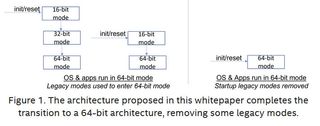Intel Explores Transition to 64-Bit-Only x86S Architecture
Legacy pruning of the architecture is outlined in a new Intel whitepaper.

Intel has published a new whitepaper (PDF) that envisions simplifying its processor instruction set architecture (ISA). The main thrust of the proposed move would be to pare back the extensive legacy support and go 64-bit only with a new and simplified 'Intel x86S' architecture. Several technical benefits are outlined in an Intel developer blog post. In summary, the legacy reduced x86S architecture removes outdated execution modes to benefit upcoming hardware, firmware, and software implementations.
Many contemporary PC users who enjoy using the latest Windows applications and games will have moved to 64-bit Windows during the Windows 7 era. This coincides with the time when system RAM amounts above 4 GB became commonplace (a 32-bit OS can only address 3.2 GB of RAM), and 64-bit applications and games started to become mainstream. So, with the current Windows 11 OS being 64-bit only and apps and games sucking up gigabytes of RAM, it seems reasonable for Intel to want to consign architectural considerations spanning all the way back to the original 8086 chip to history.
"Intel 64 architecture designs come out of reset in the same state as the original 8086 and require a series of code transitions to enter 64-bit mode," Intel explains with regard to its legacy support. "Once running, these modes are not used in modern applications or operating systems."

So, it is easy to understand there will be benefits from architectural pruning, and the complex booting process outlined above would be the first benefit observed by users of new Intel x86S chips. What are other benefits to users and developers? Intel provides the following bullet points:
- Using the simplified segmentation model of 64-bit for segmentation support for 32-bit applications, matching what modern operating systems already use.
- Removing ring 1 and 2 (which are unused by modern software) and obsolete segmentation features like gates.
- Removing 16-bit addressing support.
- Eliminating support for ring 3 I/O port accesses.
- Eliminating string port I/O, which supported an obsolete CPU-driven I/O model.
- Limiting local interrupt controller (APIC) use to X2APIC and remove legacy 8259 support.
- Removing some unused operating system mode bits.
For those interested in running older OSes and software on the latest Intel hardware, Intel suggests that there are mature virtualization-based software solutions and that users can employ virtualization hardware (VMX) "to deliver a solution to emulate features required to boot legacy operating systems." Ardent retro computing fans will also collect and use old PC systems for running their ancient software libraries. Earlier this week, we noted that there are new Intel 386 and Intel 8088 portables being developed and sold online.
Those who think that they will be impacted by the proposed Intel 64-bit only x86S architecture transition should take a closer look at the linked whitepaper, which Intel appears to have published to gauge user/developer reaction and potentially gather feedback.
Stay on the Cutting Edge
Join the experts who read Tom's Hardware for the inside track on enthusiast PC tech news — and have for over 25 years. We'll send breaking news and in-depth reviews of CPUs, GPUs, AI, maker hardware and more straight to your inbox.

Mark Tyson is a Freelance News Writer at Tom's Hardware US. He enjoys covering the full breadth of PC tech; from business and semiconductor design to products approaching the edge of reason.
-
Metal Messiah. So as per the technical theory, a direct 64-bit reset state will now eliminate several stages of trampoline code to enter 64-bit operation, since booting CPUs (SIPI) starts in real-address mode today and needs a 64-bit replacement.Reply
Intel also says that in this proposed architecture, it is possible to switch to 5-level paging without leaving a paged mode. So unnecessary legacy modes are now removed, and should lead to faster systems in the future ??
We will see how this works out though. Not very optimistic about this. -
atomicWAR Reply
Me not so much. One of the many reasons I run a PC is because of backward compatibility. I still run a ton of old programsn OSes (the big issue) and games. This would be a product I'd refuse to buy because it simply wouldn't meet my computing needs. I would prefer native compute over emulation or VM any day of the week.Mandark said:Agree with this. Hope it happens. AMD
Should also -
Finally. It's about time. There will always be whining, but it has to be done eventually. I don't think x86 can go on as is. AMD is making APU server things with ZEN4, Intel follows suit with recent announcement, ARM took it's time but there are big players like Amazon backing it up. The good old x86 needs a change or it's going to wake up in a world where it is playing a catch-up game, similarly to Intel when ZEN came out.Reply
-
danny009 No thanks, Intel/AMD needs to stop telling me what to buy,Reply
I run many games and software still runs on older side of things. I'm not going to jump into hype wagon this time, sorry. -
TerryLaze As with every news this is being overblown, just like with itanium, if intel is going to do this in the first place, they will run it alongside the normal x86 for many years, they will only completely transition if and when normal x86 sales drop to such a low point that it wouldn't make any sense for them to keep it going.Reply
As long as intel can keep making money from x86 they will keep making money from it. -
richardvday The only people affected those running Older software which most people would not even consider nowadays.Reply
There are always going to be people who fight changes. You can always run the older software in a virtual environment .
That backwards compatibility is an anchor holding both Intel and Amd back. -
kerberos_20 didnt intel already try this with IA64? and how it went, tho back then 32bit was dominantReply -
jonathanrk Reply
This is a misconception. This removes many extremely archaic modes. Most of these have to do with OS/BIOS-level code, like running 1980s DOS on bare metal. It very much does not remove the modern 32-bit-apps-on-64-bit-kernel modes – quoting the whitepaper:atomicWAR said:Me not so much. One of the many reasons I run a PC is because of backward compatibility. I still run a ton of old 32bit programs and games. This would be a product I'd refuse to buy because it simply wouldn't meet my computing needs. I guess its possible you could use an emulation layer but I would need to see this in action and even then I would prefer native compute over emulation any day of the week.
The 32-bit submode of Intel64 (compatibility mode) still exists
This is what you use every time you run a 32-bit app on your regular modern Windows or Linux install today. -
hotaru.hino This is largely removing the "Legacy Modes" defined in the current x86-64 ISA. See (from here):Reply
https://i.imgur.com/Acr98aW.png
So unless you're running a 32-bit version of Windows or some other OS that runs in one of those Legacy modes, this isn't going to affect your legacy application support.
Also fun fact, you can run 16-bit apps in Long Mode (the 64-bit mode in x86-64), but the only reason why you can't in Windows is because Microsoft didn't include any 16-bit compatibility shims like they did with 32-bit apps (also probably because they figured nobody was using 16-bit apps)
Most Popular



